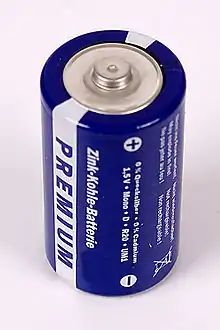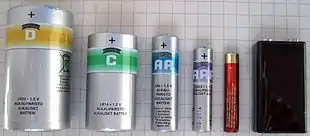D battery
A D battery (D cell or IEC R20) is a size of dry cell. A D cell is cylindrical with an electrical contact at each end; the positive end has a nub or bump. D cells are typically used in high current drain applications, such as in large flashlights, radio receivers and transmitters and other devices that require an extended running time. A D cell may be either rechargeable or non-rechargeable. Its terminal voltage and capacity depend upon its cell chemistry.


The National Carbon Company introduced the first D cell in 1898. Before smaller cells became more common, D cells were widely known as flashlight batteries. The U.S. military designation for this battery has been BA-30 since sometime before World War II.[1] During World War II, it was designated the Type C battery by the U.S. Navy, leading to confusion with the smaller C cell battery (BA-42).
In 2007, D batteries accounted for 8% of alkaline primary battery sales (numerically) in the US. In 2008, Swiss purchases of D batteries amounted to 3.4% of primary and 1.4% of secondary sales.[2][3]
Dimensions and capacity

| Zinc–carbon | Alkaline | Li-FeS2 | NiCd | NiMH | ||
|---|---|---|---|---|---|---|
| IEC name | R20 | LR20 | FR20 | KR20 | HR20 | |
| ANSI/NEDA name | 13D | 13A | 13LF | |||
| Typical capacity | charge | 8000 mAh | 12000-18000 mAh | 2000-5500 mAh | 2200–12000 mAh | |
| energy | 12 Wh | 18-27 Wh | 2.5-6.9 Wh | 2.75-15 Wh | ||
| Nominal voltage | 1.5 V | 1.5 V | 1.5 V | 1.25 V | 1.25 V | |
| Rechargeable | No | Special type only | No | Yes | Yes | |
A battery's capacity depends upon its cell chemistry and current draw. Duracell brand rates its alkaline D cell at approximately 20,000mAh at 25mA draw, but estimates performance closer to about 10,000mAh at 500mA draw.[4] This effect is generally less pronounced in cells with NiCd and NiMH chemistries; see Peukert's law. Many commonly available size D rechargeable cells are actually sub-C cells in a D-sized holder.
D batteries have:
Nominal diameter of 33.2 ± 1 millimeters (1.3 inches).
Overall length of 61.5 millimeters (2.42 inches).
[5]
Other common names
References
- "U.S. Army Flashlight".
- Life Cycle Impacts of Alkaline Batteries with a Focus on End-of-Life - EPBA-EU Archived 7 October 2011 at the Wayback Machine
- "Absatzzahlen 2008" (PDF). Archived from the original (PDF) on 25 March 2012. Retrieved 25 March 2012. INOBAT 2008 statistics.
- "MN1300 Size: D (LR20) Alkaline-Manganese Dioxide Battery" (PDF). Archived from the original (PDF) on 21 May 2012.
- IEC 60086-2 §7.1.4
External links
- Duracell D Size Battery Specification
- Energizer D Size Battery Specification for Alkaline Cell
- Brand Neutral Drawing Of NiCd D Battery Based On ANSI Specifications
- Brand Neutral Drawing Of NiMH D Battery Based On ANSI Specifications
- Brand Neutral Drawing Of Alkaline D Battery Based On ANSI Specifications
| Wikimedia Commons has media related to D batteries. |